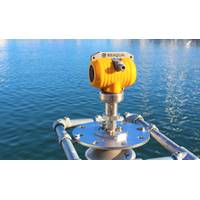
Inside the new UK Center for Seabed Mapping
to become available for civil use, but it was limited in terms of its constellation.”At the time GPS was intentionally degraded by the US government, and “what could have been 10-meter accuracy became 50-meter accuracy, for example,” said Parker. “We were still using land-based microwave ranging systems and the like, which took a lot more effort to set up, manage and maintain. [Back then] you would spend a quarter of your day sorting out where you are. These days, you flick a switch and it just happens and nobody thinks about it anymore.”“Of course, the outcome of this

Lidar Helps to illuminate the Future of Oceans
. One tactic to overcoming these limitations, however, may use more than just lidar.Engineers at Stanford University have developed an aerial solution for underwater imaging by combining light and sound, each filling in the gaps created by the other. Electromagnetic radia-tion (such as visual light, microwave, and radar signals) loses energy when passing from the air to the water and vice versa; soundwaves struggle in a similar sense. The hybrid Photoacoustic Airborne Sonar System (PASS) leverages the best of both, with the hope of eventually conduct-ing largescale aerial marine surveys that are comparable

RS Aqua launches WaveRadar REX2
next generation WaveRadar, the WaveRadar REX2. In been in development for several years, the WaveRadar REX2 is half the size and weight of the legacy REX, consuming 10 times less power while offering a 25% greater range and still maintaining its accuracy.The WaveRadar REX2 is powered by a new Emerson microwave sensor, using the same Frequency Modulated Continuous Wave (FMCW) measurement technique that has been used by the WaveRadar REX over the past 20 years. This new higher frequency sampling unit enables a greater measurement range of up to 80 m, and the same high accuracy over this distance (3 - 6

Miros RangeFinder Achieves Certification
oil and gas production environments. The motion compensated version of the Miros RangeFinder, WaveFinder, is also certified for use in Zone 1.The RangeFinder is said to offer up to 15% higher operational availability and increased operational safety, the Miros sensor is a high-frequency vertical microwave radar that provides sea level, tide, non-directional wave monitoring, ride control and air gap measurements.Unlike laser sensors, the RangeFinder is undisturbed by fog, rain and water spray, giving measurements with +/- 1-millimeter accuracy in all weather conditions. The sensor is dry-mounted

Armstrong Marine Delivers R/V to University of AK
8’ x 8’ grid of deck tie-downs lend further versatility.Inside the heated full-width cabin, three shock-mitigating Bentley’s seats accommodate captain and crew. A dinette/chart table, with storage below, provides additional seating and converts to a bunk. The galley includes a sink, microwave/convection oven, Norcold refrigerator, and So-Low freezer. Liftout hatches in the floor and a wet locker with internal dehumidifier provide additional storage access.The cuddy cabin features four sleeping bunks, storage lockers, and a Lewmar egress hatch. The head, featuring portlight and sink/vanity

MTR100: The Ones to Watch
is suitable for data-only or low-power applications, with 24v DC, 50 Watt power transfer and 100 Mbps Ethernet plus serial data transfer, while Fonn offers 24v DC, 250 Watt power transfer. Both have the same Ethernet and serial data transfer as Torden.WiSub’s connectors use high-frequency microwave communication electronics to transfer data at high speed and use inductive resonance to transfer power, as they can coexist without interference. Using induction and microwave electronics also means the connectors have axial freedom and wide angular misalignment tolerances and don’t face
WiSub’s Universal AUV Connector
. There are further enhancements that an intelligent connector can provide which ‘simple’ pins cannot, such as localized network diagnostics.” One of the vital breakthroughs that made the UAC concept viable relates to WiSub’s patented high-speed, high frequency microwave electronics technology – “EM-based communication has been known for decades in the radio-frequency range (below 300 MHz), and has been applied to low-speed data transmission over short distances (some meters). High frequency data transmission has been ignored due to its very high attenuation

Emerson Launches Salinity Measurement System
production, such as scaling, hydrate formation and corrosion. The onset of formation water and its salinity, if not controlled, can lead to well shutdowns and cost producers millions in unplanned shutdown time. The system, which is a key element of the Roxar Subsea Wetgas Meter and is based on microwave (MW) resonance technology, provides quantitative and qualitative real-time salinity measurements in many types of field conditions but, particularly, in the high gas volume fraction (GVF)/wet gas flows that characterize wet gas fields. “With oil and gas wells being produced

World’s First Floating Microwave Radiometer
World’s first floating microwave radiometer complements measurements of the first floating LiDAR AXYS Technologies Inc. said it is conducting design work with Boulder Environmental Sciences & Technology (BEST) is to deploy the world’s first buoy based microwave profiling radiometer on a floating platform, the FLiDAR WindSentinel. Funded by the U.S. Department of Energy, the BEST Marine Profiling Radiometer (MPR) is the world's first microwave profiling radiometer specifically designed for deployment on a buoy. Once completed, the system will enable users to
 August 2025
August 2025





